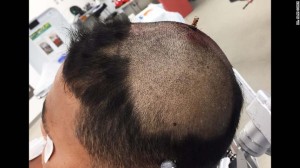A 12 year old boy is lucky to be alive following a freak accident that caused a screw to pierce his skull. The screw came within millimeters of a major vessel that carries blood from the heart to the brain, and if it weren’t for the good judgment of his parents, first responders and medical personnel, chances are that it would have cut through the vessel and caused the boy to bleed out in a matter of minutes.
While this story has a happy ending, the accident could have been avoided if some basic precautions were made ahead of time. Let’s look at what happened as a reminder of the important role that prevention plays in keeping us safe.
What Went Wrong
The boy was building a tree house in his back yard, and he fell after the branch that he was climbing on snapped. As he fell, a board with a long screw sticking out of it got knocked over and landed on his head. The screw penetrated the skull and ended up precariously close to the major vessel that travels between the two lobes of the brain and drains blood from the brain back to the heart. While the screw didn’t penetrate deep into his skull, it came close enough that even the slightest movement could have had disastrous consequences.
Initially, the boy had no idea he was hurt, and he attempted to go about his business. His mother noticed the board sticking out of his head and got him to remain still before calling 911. Once first-responders arrived, they immobilized the board and prepared the boy to be airlifted to the hospital. However, once they reached the helicopter, they realized that the door to the helicopter was too narrow for the boy and the board to fit through.
A larger helicopter was called to the scene while rescuers carefully trimmed-off the sides of the board to make it smaller. Keep in mind that this was a very delicate procedure to do in the field as any vibration or movement could have caused the screw to penetrate the vessel. They eventually got the boy inside of the helicopter and he was transported to the closest trauma center where it took surgeons nearly 7 hours to remove the screw and patch up the hole in his skull. The boy made a full recovery and went home a short time later.
Aside from the immediate danger that the screw posed, another major setback in this incident was that it took so long to get the boy to definitive care. Remember that the goal is to have a trauma victim stabilized and delivered to the emergency room within an hour following an accident. However, the field work, as well as waiting for the second helicopter to arrive, stole precious time that could have been disastrous if the boy’s condition deteriorated.
What Went Right
The mother correctly identified the potential severity of the injury despite the fact that it didn’t look so bad at first glance. There wasn’t a lot of blood, and he wasn’t in a lot of pain. However, she didn’t take any chances. The first-responders should also be applauded for how they delicately-handled the situation as well. Everyone remained focused, tried to minimize risk, and they worked as a team as they erred on the side of caution. If someone tried to dislodge the screw or roughly-cut the board, chances are that the outcome would have been entirely different.
Lessons for Us
While this was undoubtedly a freak accident, keeping the area clear of potential hazards would have prevented it from occurring in the first place. It’s easy to ignore potential dangers and take safety for granted while working on projects, because the chances of something going wrong may seem minimal at the time. However, as this accident illustrates, it only takes one mishap to set-off a chain reaction of events that can have disastrous consequences. Another lesson is that knowing first aid isn’t enough. We also need to know how to administer it safely, and a big part of this is being able to think a few steps ahead as we develop a plan to get the victim stabilized. This comes with training, experience and the ability to use good judgment in the field. Consequently, the more hands-on experience we have can translate into making good decisions during a crisis.
A little bit of preparation can prevent a lot of mishaps from occurring in the first place, but knowing what to do after the fact is equally important. Let this story remind us of the importance of being proactive in order to minimize risk while also being able to respond appropriately when things go wrong.

